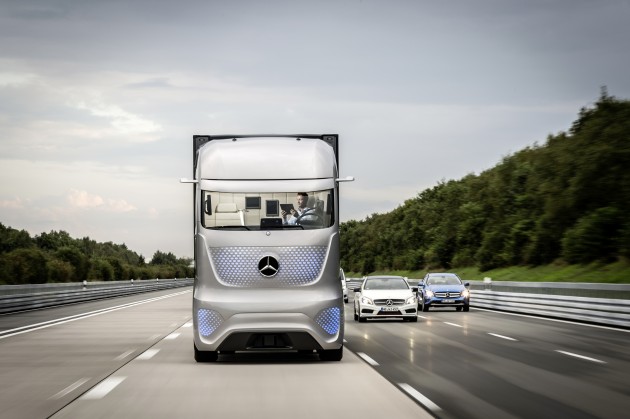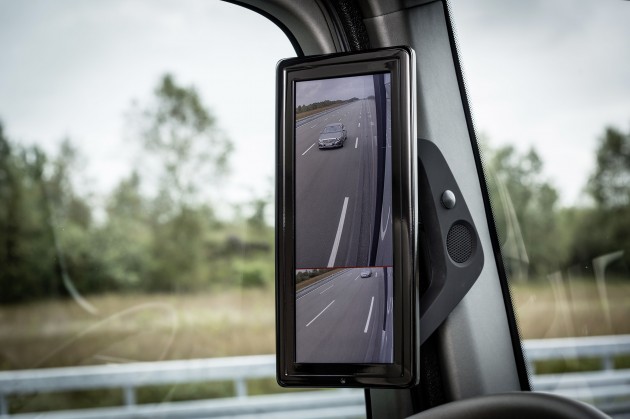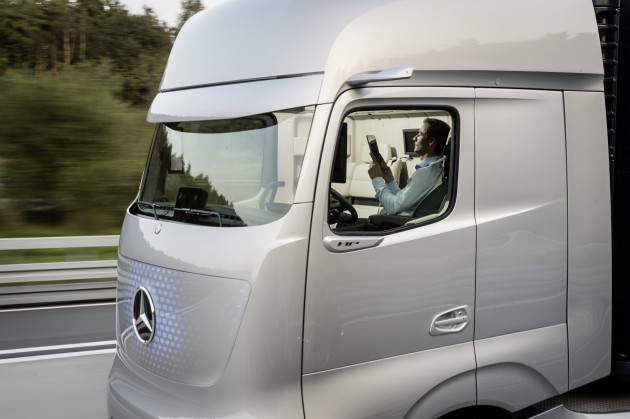Daimler offers first complete look at its autonomously-driven Future Truck
HANNOVER, Germany — It has no headlights, no rearview mirrors and virtually no grille. Yet this, according to Daimler, is the future of truck transportation.
Daimler tonight, for the first time, removed the mask from its Mercedes-Benz Future Truck 2025, which was first demonstrated for industry journalists on a stretch of German Autobahn in July. At that time, the truck’s identity was mostly concealed by a camo-style paint scheme designed to tease the eye and keep secret the more intricate details of the design. That mask came off tonight in front of more than 500 industry journalists from 30-plus countries from around the world, on the eve of the IAA Commercial Vehicles show in Hannover, Germany.

Dr. Wolfgang Bernhard, the head of Daimler trucks globally, made a gutsy entrance to the press event, piloting the Future Truck in autonomous Highway Pilot mode into an airport hangar where the unveiling took place.
“This night was a very special one for me,” said Bernhard, who used to oversee Daimler’s Mercedes-Benz passenger car division. “It’s the first time I was driven on stage and not driving. That’s what our truck has in common with all those airplanes out there in the airport – both can run on autopilot.”
While the technology built into the Mercedes Future Truck 2025 has already been demonstrated, the focus today was on its interior and exterior design.
“Tonight, we are showing you the complete package of all the features together,” Bernhard said. “If technology is the heart of the Future Truck, the design is the soul.”
The Future Truck has a clean front end with no visible headlights. They are hidden underneath the skin of the cab and shine out from beneath the paint. There is no traditional grille on this truck; instead there are lights underneath the paint that turn on when the truck is started. The grille displays white LED lights when the truck is manually driven and pulsating blue lights when it’s on autopilot.
Instead of traditional rearview mirrors, the Future Truck has a camera system that gives the driver a more complete view down the sides of the vehicle via 12-inch displays mounted inside the cab. This not only reduces aerodynamic drag, but also improves visibility. The cameras even self-adjust depending on the course the truck is taking to provide the driver with the most important sightline.
“We have verified our aerodynamic improvements in wind tunnels and can see clear and significant benefits,” Bernhard said. They also provide better nighttime visibility and are less sensitive to rain and dirt.

The interior of the Future Truck was equally intriguing. In place of a passenger seat, a lounge chair has been installed. The centre console has been removed and so have most of the rocker switches and gauges found on today’s truck dashboards. Instead, a tablet has been installed on the dash. It displays to the driver only the most important information. Once removed from its mount, the driver can access entertainment and gaming functions, including Skype. When Highway Pilot is enabled at speeds of up to 80 km/h, the driver can pivot his seat 45 degrees, dismount the tablet and play games, read a book or do some work.
The Future Truck uses its multiple radar systems to detect what’s going on around it and adjusts its speed and positioning accordingly. In this sense, the Future Truck is just like a modern airliner, which when placed on autopilot takes the steering of the plane out of the pilots’ hands.
Behind the tuck was an aerodynamically-optimized trailer, which Daimler says produces 18% less aerodynamic resistance than today’s offerings.
Sven Ennerst, chief engineer of the Mercedes-Benz Future Truck, declared it “the world’s first completely autonomously-driven truck,” and said, “We are sticking to our ambitious goals of accident-free driving, maximum fuel efficiency and the establishment of a system of intelligent connectivity.”
Some of the technologies found on the Future Truck are already available today, including the Blind Spot Assist, which uses radar on the passenger side of the vehicle to detect when the truck could potentially turn into moving or stationary objects.
The Future Truck’s eyes come in the form of a stereo camera mounted behind the windshield, which sees everything in front of its lens up to 328 feet away. This is complemented by two additional sensors – short- and full-range radars – located near the bottom of the front end of the Future Truck. More radars provide visibility of what’s alongside the truck and trailer.

“None of these sensors is new,” Ennerst said. “What’s new is the Future Truck merges them together to create a phenomenal team. They’re all intelligently linked. Its brain is a central computer system with a high-performance microprocessor. The Future Truck 2025 always knows what’s happening in front and next to it. It can, by itself, scan its surroundings and respond to any situation.”
One of the greatest benefits, Ennerst said, is the truck’s ability to relieve the driver from monotonous driving activities and to take control and always remain on high alert. It could also reduce congestion. Because the Future Truck is linked with its surroundings and can read 3D roadmaps, it can evaluate possible alternative routes and topography and suggest alternatives based on current traffic situations.
Through vehicle-to-vehicle communications, it could also alert drivers to potential dangers beyond the next corner.
“The Future Truck 2025 is more than just a transport vehicle,” Ennerst said. “It is a new way of driving, designed to bring man and machine together as a team.”
Discussing the design of the truck, chief designer Gorden Wagener said it was designed to appeal to buyers’ senses of intelligence and emotion, while optimizing efficiency. Daimler designers started out with their ideal cabover truck design and began to remove hard edges, or lines, from it one by one to improve aerodynamics.
“If you like it, take a line off. If you still like it, take another line off,” Wagener explained.
Inside, designers aimed to replicate the modern paperless office with a tablet-focused interior.
Now that the truck has been designed and unveiled in all its glory, Bernhard said the next step is to get government on-board in allowing autonomously-driven trucks to travel existing highways. The technology demonstration held in Magdeburg, Germany in July was a great start. Bernhard said it generated 270 press articles, reaching 26 million readers around the world.
“We have set things in motion and that was our target,” Bernhard said. “We need national lawmakers to take action…we need dialogue and we need discussion, as soon and as openly as possible.”
Have your say
This is a moderated forum. Comments will no longer be published unless they are accompanied by a first and last name and a verifiable email address. (Today's Trucking will not publish or share the email address.) Profane language and content deemed to be libelous, racist, or threatening in nature will not be published under any circumstances.
Sounds like utopia. Take a bunch of circuits, electronics, sensors, add some road salt, corrosive road cleaning materials, dirt, sand, rain, snow, wind and send it all down a beat up, rough, pounding highway at 50 – 70 miles per hour and what could wrong…? I mean we all know that computers and electronics never fail us, right?
And if another vehicle happens to sideswipe the truck and wreck a camera or sensor, or something else damages one of the sensors, no problem. None of these common every day issues will create havoc with this machine because we’ll stop living in “realsville” and we’ll be opertaing in utopia. I can see it would stand up real well in the oil patch or a construction site. Ooops, sorry thats “realsville”, not Utopia. My mistake.
Til then I prefer a Peterbilt / Kenworth with a dashboard full of guages and switches that glow & sparkle to keep me smiling as I go down the road.
This truck will not run or operate in -40f weather in canada.Yes you can say planes do but the snow an grim will rise problems.I,ve been trucking for 40 years i would not take the change on this truck in northern canada… thank you











I’m a bit confused.
I thought that the whole point of autonomous trucks was to get rid of the driver completely.
The way that this article is written just describes a scenario where there will still be a driver but he or she can basically get paid to play games.
So what I want to know is this;
Is this truck capable of driving itself from a dispatcher to a receiver at any speed and any condition at all speeds?
If the answer is yes then what is the point of having a driver?
If the answer is no then what is the point of this truck?
What would happen if this truck was barrrelling down the highway, and the driver had a heart attack and died?